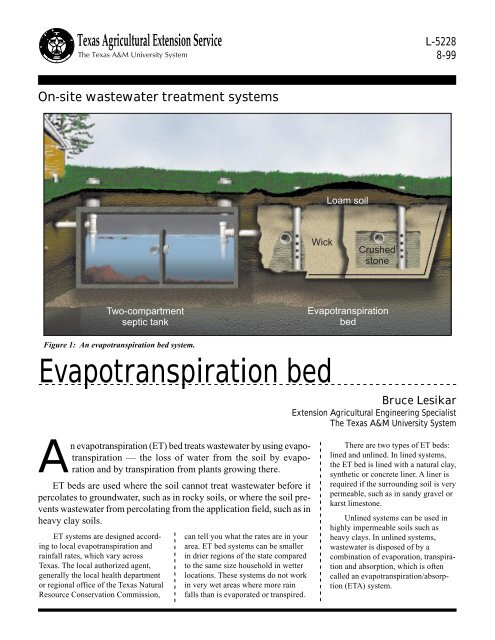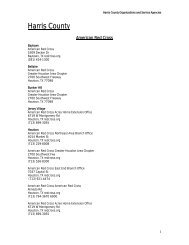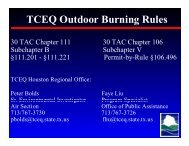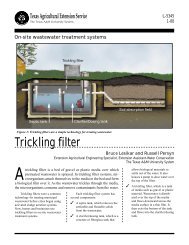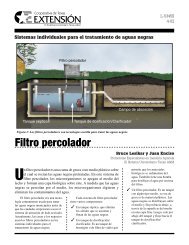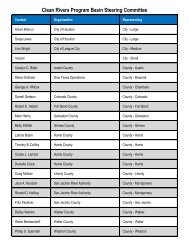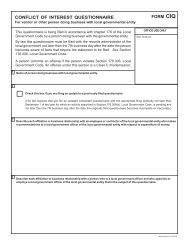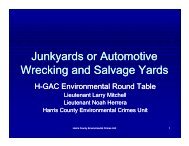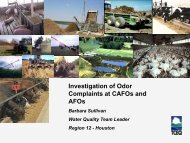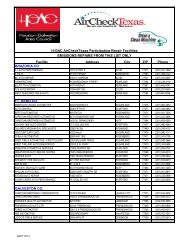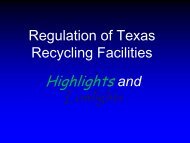Evapotranspiration bed - Department of Biological & Agricultural ...
Evapotranspiration bed - Department of Biological & Agricultural ...
Evapotranspiration bed - Department of Biological & Agricultural ...
Create successful ePaper yourself
Turn your PDF publications into a flip-book with our unique Google optimized e-Paper software.
L-5228<br />
8-99<br />
On-site wastewater treatment systems<br />
Loam soil<br />
Wick<br />
Crushed<br />
stone<br />
Two-compartment<br />
septic tank<br />
<strong>Evapotranspiration</strong><br />
<strong>bed</strong><br />
Figure 1: An evapotranspiration <strong>bed</strong> system.<br />
<strong>Evapotranspiration</strong> <strong>bed</strong><br />
Bruce Lesikar<br />
Extension <strong>Agricultural</strong> Engineering Specialist<br />
The Texas A&M University System<br />
An evapotranspiration (ET) <strong>bed</strong> treats wastewater by using evapotranspiration<br />
— the loss <strong>of</strong> water from the soil by evaporation<br />
and by transpiration from plants growing there.<br />
ET <strong>bed</strong>s are used where the soil cannot treat wastewater before it<br />
percolates to groundwater, such as in rocky soils, or where the soil prevents<br />
wastewater from percolating from the application field, such as in<br />
heavy clay soils.<br />
ET systems are designed according<br />
to local evapotranspiration and<br />
rainfall rates, which vary across<br />
Texas. The local authorized agent,<br />
generally the local health department<br />
or regional <strong>of</strong>fice <strong>of</strong> the Texas Natural<br />
Resource Conservation Commission,<br />
can tell you what the rates are in your<br />
area. ET <strong>bed</strong> systems can be smaller<br />
in drier regions <strong>of</strong> the state compared<br />
to the same size household in wetter<br />
locations. These systems do not work<br />
in very wet areas where more rain<br />
falls than is evaporated or transpired.<br />
There are two types <strong>of</strong> ET <strong>bed</strong>s:<br />
lined and unlined. In lined systems,<br />
the ET <strong>bed</strong> is lined with a natural clay,<br />
synthetic or concrete liner. A liner is<br />
required if the surrounding soil is very<br />
permeable, such as in sandy gravel or<br />
karst limestone.<br />
Unlined systems can be used in<br />
highly impermeable soils such as<br />
heavy clays. In unlined systems,<br />
wastewater is disposed <strong>of</strong> by a<br />
combination <strong>of</strong> evaporation, transpiration<br />
and absorption, which is <strong>of</strong>ten<br />
called an evapotranspiration/absorption<br />
(ETA) system.
Grass cover<br />
is important<br />
for transpiration<br />
<strong>of</strong> wastewater<br />
Treatment<br />
In ET <strong>bed</strong> systems, solid materials<br />
are removed from the wastewater<br />
by a septic tank. Then the wastewater<br />
is distributed throughout the ET <strong>bed</strong><br />
system. There, final treatment and<br />
disposal occur when the water<br />
evaporates and plants use nutrients in<br />
the effluent and release moisture<br />
through transpiration.<br />
As the water evaporates, salts,<br />
minerals and solids from the effluent<br />
accumulate in the <strong>bed</strong>. During very<br />
wet periods when evapotranspiration<br />
is low, ET <strong>bed</strong>s store water until drier<br />
periods when it evaporates and<br />
transpires.<br />
Design<br />
An ET <strong>bed</strong> contains storage<br />
trenches, loam backfill around the<br />
trenches and sandy loam soil over the<br />
top <strong>of</strong> the loam backfill for grass<br />
growth. Generally, the required <strong>bed</strong><br />
surface area is divided between two<br />
<strong>bed</strong>s, which allows for switching<br />
between the <strong>bed</strong>s to avoid overloading.<br />
A liner and sand cushion are<br />
placed in the ground, and the storage<br />
system is set on the <strong>bed</strong> bottom.<br />
Generally, the storage system consists<br />
<strong>of</strong> a <strong>bed</strong> <strong>of</strong> rocks or gravel <strong>of</strong> a<br />
uniform size ranging from 3/4-inch to<br />
2 inches in diameter, filling the <strong>bed</strong> to<br />
a depth <strong>of</strong> 12 inches or less, depending<br />
on the <strong>bed</strong>’s overall depth.<br />
Distribution pipes are placed no more<br />
than 4 feet apart and no more than 2<br />
feet from the <strong>bed</strong> walls. The top <strong>of</strong> the<br />
distribution pipe must be flush with<br />
the top <strong>of</strong> the rock media.<br />
Other types <strong>of</strong> media such as tire<br />
chips, or storage systems such as<br />
leaching chambers, may be used for<br />
the storage trenches.<br />
A water-permeable soil barrier (a<br />
geotextile filter fabric) is placed over<br />
the rock. A loam soil is added to fill<br />
the <strong>bed</strong> to within two inches <strong>of</strong> the<br />
top. Selecting the proper soil is<br />
extremely important in building an ET<br />
system. (State regulations classify the<br />
soil as a class II, loamy soil.) The soil<br />
draws the water toward the surface<br />
faster than coarse sand.<br />
Wicks incorporated into the rock<br />
media draw water continuously from<br />
the rocks into the soil and toward the<br />
surface area, where it evaporates or is<br />
taken up by plants. A wick is a<br />
column <strong>of</strong> soil that extends through<br />
the rock media to the bottom <strong>of</strong> the<br />
<strong>bed</strong>. The total wick area should be 10<br />
to 15 percent <strong>of</strong> the <strong>bed</strong> surface and<br />
should be uniformly spaced throughout<br />
the <strong>bed</strong>.<br />
After the loamy soil is in place,<br />
the final two inches are filled with<br />
sandy loam and mounded in the<br />
center with a slope <strong>of</strong> 2 to 4 percent<br />
toward the outside <strong>of</strong> the <strong>bed</strong>. The last<br />
step is to plant vegetation specially<br />
selected to transpire the most water,<br />
such as bermudagrass or St. Augustine<br />
grass. Placing grass sod over the<br />
<strong>bed</strong> may be the best approach to<br />
establishing grass there. Using seed<br />
may let the mounded soil wash away<br />
during heavy rainfall before the grass<br />
is established. Larger plants with<br />
shallow root systems, such as evergreen<br />
bushes, may also be used to<br />
help take up water.<br />
If you use grasses with dormant<br />
periods, be sure to provide adequate<br />
vegetation on the <strong>bed</strong>s during these<br />
periods. A common solution is<br />
overseeding with winter grasses to<br />
provide year-round transpiration.<br />
How to keep it working<br />
A valve connecting the two <strong>bed</strong>s<br />
allows you to alternate the wastewater<br />
inflow between each <strong>bed</strong>. When one<br />
<strong>bed</strong> becomes saturated, turn the valve<br />
to send effluent into the other underloaded<br />
<strong>bed</strong>. An inspection port added
2 to 3 inch perforated<br />
monitoring pipe<br />
Sandy loam-slope<br />
Surface to drain<br />
Loam soil<br />
Loam soil<br />
Geotextile<br />
fabric<br />
18" min<br />
36" max<br />
12"<br />
3 to 10 inch<br />
distribution<br />
pipe<br />
Crushed<br />
stone<br />
Sand<br />
cushion<br />
Alternate<br />
crushed stone<br />
<strong>bed</strong><br />
4 foot<br />
space<br />
2 foot<br />
maximum<br />
spacing<br />
PVC liner<br />
Figure 2: <strong>Evapotranspiration</strong> <strong>bed</strong>s should be built as shallow as possible, from<br />
18 inches to a maximum <strong>of</strong> 36 inches deep.<br />
to each <strong>bed</strong> will help you determine<br />
each <strong>bed</strong>’s water levels during use.<br />
Covering the port prevents insects,<br />
small animals and unauthorized<br />
people from getting to the bottom <strong>of</strong><br />
the <strong>bed</strong>.<br />
Here’s how to maintain your ET<br />
<strong>bed</strong> properly:<br />
✓ Mow the grass cover regularly.<br />
Grass cover is important for<br />
transpiration <strong>of</strong> wastewater.<br />
Overseed with a cool-season<br />
grass to provide transpiration in<br />
winter. If you do not maintain the<br />
grass cover, the system will<br />
probably fail.<br />
✓ Divert rainfall run<strong>of</strong>f around the<br />
system. The system is designed to<br />
handle normal rainfall entering<br />
from the top <strong>of</strong> the system, but<br />
excessive rainfall will overload it.<br />
Rainfall run<strong>of</strong>f from buildings<br />
and paved areas can add too<br />
much water to the ET <strong>bed</strong>. This<br />
water must be diverted around the<br />
system. Maintain the sloped<br />
cover on the system to help rain<br />
run <strong>of</strong>f the <strong>bed</strong>.<br />
✓ Check the vegetation growing on<br />
the system as the system matures.<br />
You may need to use salt-tolerant<br />
grasses, such as bermuda-grass,<br />
because salt accumulates in the<br />
system. Water leaves salts in the<br />
soil when it evaporates. Harvesting<br />
the salt-tolerant grasses may<br />
reduce the salts in the system if<br />
the plants can accumulate the salt<br />
in their leaves. The potential for<br />
high salt concentrations depends<br />
on how much salt is in the water<br />
supply.<br />
✓ Develop good water conservation<br />
habits at home. Excessive water<br />
use overloads the system and<br />
causes failure.<br />
To keep the <strong>bed</strong>s aerobic and<br />
prevent clogging, build them as<br />
shallow as possible, from 18 inches<br />
to a maximum <strong>of</strong> 36 inches deep.<br />
Divert<br />
rainfall run<strong>of</strong>f<br />
around the system
The On-Site Wastewater Treatment Systems series <strong>of</strong> publications is a result <strong>of</strong> collaborative efforts <strong>of</strong> various agencies,<br />
organizations and funding sources. We would like to acknowledge the following collaborators:<br />
Texas State Soil and Water Conservation Board<br />
Texas On-Site Wastewater Treatment Research Council<br />
Texas Natural Resource Conservation Commission<br />
USDA Water Quality Demonstration Projects<br />
Consortium <strong>of</strong> Institutes for Decentralized Wastewater Treatment<br />
USEPA 319(h) Program<br />
Texas <strong>Agricultural</strong> Extension Service<br />
Texas <strong>Agricultural</strong> Experiment Station<br />
Texas On-Site Wastewater Association<br />
USDA Natural Resources Conservation Service<br />
Produced by <strong>Agricultural</strong> Communications, The Texas A&M University System<br />
All publications in the On-site Wastewater Treatment Systems series can be downloaded free from the World Wide Web at:<br />
http://agpublications.tamu.edu/pubs/ewaste<br />
Educational programs <strong>of</strong> the Texas <strong>Agricultural</strong> Extension Service are open to all people without regard to race, color, sex, disability, religion, age or national origin.<br />
Issued in furtherance <strong>of</strong> Cooperative Extension Work in Agriculture and Home Economics, Acts <strong>of</strong> Congress <strong>of</strong> May 8, 1914, as amended, and June 30, 1914, in cooperation with the United States<br />
<strong>Department</strong> <strong>of</strong> Agriculture. Chester P. Fehlis, Deputy Director, The Texas <strong>Agricultural</strong> Exension Service, The Texas A&M University System.<br />
30,000 copies, Revision ENG<br />
For Sale Only $1


